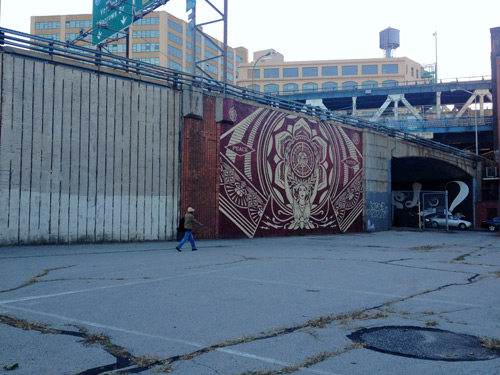Take a walk in this park — it’s pretty much all you can do.
A city-block-sized slab of crumbling concrete along Jay Street below the Manhattan Bridge approach does not have so much as a basketball hoop and its name, Bridge Park 2, gets the post-Soviet feel of the place about right, park-goers say.
“It’s sort of like just some field that they have no grass for,” said Maggie Liu, a middle school student who does not play in the park but occasionally uses it as a shortcut on her walks home. Not at night, though. Liu says that it is too scary then.
A visit on Tuesday morning saw a photographer using the park as a gritty backdrop for a fashion shoot, but the space, which does contain a rusty playground behind a chain link fence, was otherwise deserted.
“I don’t really see anyone playing in this park,” Liu said. “Sometimes they’ll be playing catch, but that’s about it.”
Compare that to the crowds and plush facilities at Brooklyn Bridge Park, less than a 10-minute walk away. Brooklyn Bridge Park is run by a public-private partnership with a $16-million operating budget, far more than the amount dedicated to most city parks — and it shows. The plush green space contains a hand-painted carousel, sand volleyball courts, and themed playgrounds including Sandbox Village and Swing Valley.
On Friday afternoon Bridge Park 2 was mostly deserted, but Brooklyn Bridge Park was jumping and people this paper polled there had never heard of the waterfront green space’s barren sibling, though they were not surprised to hear that such a crumbling park exists.
“Some of the interior parks of Brooklyn are pretty under-resourced,” said Sara DeRose, sitting in Brooklyn Bridge Park on a break from her job at the Brooklyn Arts Council. “I think everyone should agree that resources should be distributed across the city, but this is a tourist attraction–type park.”
The parks department is currently planning a renovation of Bridge Park 2, a spokeswoman said, though she would not elaborate on what is planned or how much the park currently costs to maintain.
The park is one of three numbered Bridge Parks set aside as part of a deal struck by the city for recreation space that was supposed to mitigate the construction of the Brooklyn-Queens Expressway in 1944. The Parks Department took over in 1947 and planted London plane trees, which became popular in the English city during the Industrial Revolution when city planners realized that the plants thrived despite coal-polluted air.
Dumbo’s three grim expanses remained nameless for most of the 20th century until park officials finally gave the places their current, unimaginative titles in 1998. The borough still has 15 anonymous parks today
Bridge Park 1 and Bridge Park 3 are, like park 2, decidedly minimalist. Park 3 is home to a single basketball hoop and park 1 boasts a few benches, making park 2’s creaky jungle gym seem deluxe in comparison.


























